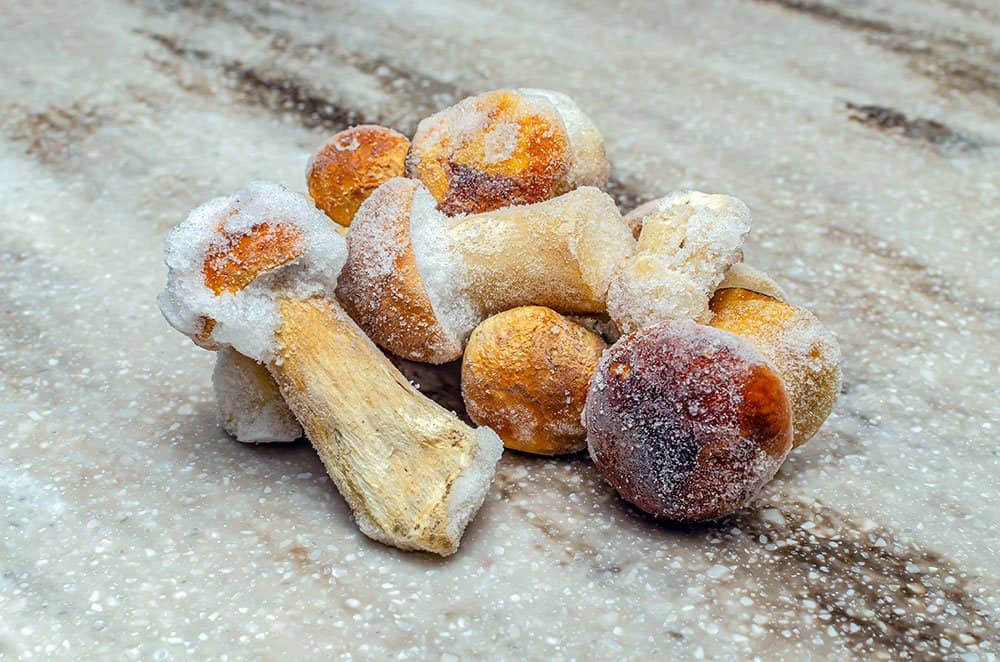Table of Contents
When mushroom season is in full swing, it’s easy to overstock on the wonderful variety of fungi you can find.
Do you have more mushrooms than you can manage? Learning how to freeze mushrooms is a great way to keep them from going to waste.
Opinions vary on the best way to freeze mushrooms, and there’s no one “right” way to do so.
But achieving the basic aim—saving the mushrooms’ fresh form and flavor—is a simple 3 step process.
How to freeze Mushrooms the right Way
Step 1: Sort and Clean
You should always start your storage process with fresh, clean mushrooms. In the fridge, most mushrooms will keep for about a week.
After this point, check them for signs of rot (slime, mold, dark spots, foul odors, etc.). Discard any that appear to be past their prime.
Once you’ve sorted out the storable shrooms, go back through the bunch with a soft brush or cloth to remove any dirt.
If you’ll be using these in stuffed mushrooms, now’s the time to separate the caps and stems. Otherwise, trim the ends of any rough-looking or woody stems at this point.
It’s usually advised that you don’t clean mushrooms under running water. They quickly soak up moisture and can become soggy once you cook them. You can, though, use a damp cloth to remove any of the more stubborn dirt.
Now that your mushrooms are clean, you come to your first choice in the freezing process: to cook or not to cook?
You can, if you’re not super concerned about retaining the mushrooms’ texture, skip to Step 3 now. Cooking before freezing is recommended, but optional.
Step 2: The Quick Cook
To keep your mushrooms feeling firm and tasting fresh as can be, you’ll want to either steam blanch or sautée them.
Cooking mushrooms before they’re frozen can have many benefits:
- Inactivates food-spoiling enzymes and bacteria
- Allows for longer freezer storage
- Aids in nutrient preservation
- Retains texture and color upon thawing
- Improves bioavailability of certain nutrients
This step isn’t crucial, but it’s the key to keeping your frozen mushrooms from being slimy when you cook them.
Steam Blanching
Steam blanching is the preferred cooking method for freezing most whole mushrooms. If you’re planning a meal where you want to showcase the caps, you’ll want to use this steam blanch method.
All you need for steam blanching is a large pot, a few cups of water, and a steamer basket. Bring the water to a boil, place your basket of sliced or whole mushrooms inside, and let the steam work its magic.
Depending on the size of the mushroom pieces, you’ll need to blanch them between 3 to 5 minutes. If your mushrooms vary much in size, it can be a good idea to sort them first and blanch similar sizes together.
Generally, large whole mushrooms will take 5 minutes to blanch. Button mushrooms and quartered mushrooms take around 3.5 minutes. Small mushroom slices only need 3 minutes of blanching.
It’s better to over-blanch than to under-blanch. So if you think they may not be fully steamed, give them another minute or so.
Steam blanching can lead to discoloration or darkening of your mushrooms. But, it’s easy to prevent this with the addition of a little acid.
There are two ways to do this. Your first option is to soak your mushrooms in a mix of 2 cups water and 1 teaspoon of lemon juice for 5-10 minutes. The other way is to add a teaspoon of lemon juice to your steaming water. Either of these extra steps will help your mushrooms retain their earthy coloration.
Sautéeing
For a firmer frozen fungus perfect for mushroom risotto or hearty stews, a quick sautéeing is the trick.
Sautéeing releases some of the excess water that would damage the mushrooms upon turning to ice. This small step goes a long way in preserving the freshness of the shrooms’ texture.
You can sauté can with or without oil, and you can use whole, sliced, or diced mushroom pieces.
Simply bring a large skillet to high heat and add a small amount of butter or olive oil (optional). Then, add the mushrooms.
It’s important to stir your mushrooms frequently while they’re cooking so that they don’t burn. You may add salt and spices if you wish, but the main purpose of this step is simply to cook off some moisture.
Take the frying pan off the heat after 3-5 minutes, or once the mushrooms have started to become tender. They should be just under fully-cooked.
Place them on a plate, paper towel, or baking sheet to cool. Then, your cooked mushrooms will be ready for the freezer.
Step 3: Portion and Freeze
You’re almost at the end of the mushroom freezing process.
Depending on how many mushrooms you’re saving, you may want to separate them into portions at this point. Again, this isn’t necessary, but it’s a time-saver in the end.
Like cooking, you can go about portioning a few different ways. The first and simplest is the use of individual freezer-safe bags. These thick-walled plastic bags come in a range of sizes, from a pint to multi-gallon. If you’re ready to wrap this up, sort your mushrooms into appropriately-sized bags and stick ‘em in the icebox.
An alternative to freezer bags is to use airtight containers for storage. This can be any freezer-safe container—even mason jars— so long as it has a good seal. For larger containers, use parchment paper to separate your mushrooms into serving-size layers.
Whatever container you use, be sure to leave around a half-inch of empty space at the top. As the mushrooms freeze, they’ll expand and can break an over-full container.
Flash Freezing
Some recipes, like grilled portobello mushrooms, call for nicely-presented whole caps. For the best-frozen mushrooms, you’ll want to use a method called flash freezing. This is another step you can skip. But doing this will give you beautiful, individual mushrooms to use in a wide variety of recipes. It can also help to further preserve the mushrooms’ earthy flavor and firm texture.
Flash freezing is easier than it sounds. All you need to do is to spread your mushrooms in a single layer on a cookie sheet and then place this tray in the freezer. If you’re starting with completely cooled mushrooms, you should only need to wait around half an hour.
Once the individual mushroom pieces are frozen, remove them from the sheet. This might be easier if you first line the sheet with parchment paper, and you can always enlist a spatula to help. Next, transfer the mushrooms into a freezer-safe bag or container. And finally, put them back in the freezer.
Voila! You now have flash-frozen mushrooms!
One of the bonuses of flash freezing is that you don’t need to use portion-sized containers in the freezer. The individual mushroom pieces won’t stick together in a frozen lump, so it’s no fuss to take what you need for each dish.
To prevent freezer burn, be sure to press as much air from your bags as you can. If you’re storing gourmet mushrooms, you might want to invest in a vacuum freezer bag system. The less air in your containers, the longer your mushrooms will keep. A freezer bag sealer can help keep your mushrooms free of freezer burn for up to 12 months.
How to use frozen Mushrooms
No matter how fresh your button mushrooms are when you freeze them, you likely won’t want to use them cold in a salad. There’s no stopping at least a mild sliminess once they thaw out.
Because of this, frozen mushrooms are best used for cooking. In most cases, you can add frozen mushrooms straight to the dish with no need for thawing.
For recipes that cook up fast—like stir-fries—you can thaw your mushrooms in the fridge overnight.
What you should know before freezing Mushrooms
Some mushrooms freeze better than others. And some, especially wild mushrooms, might need other preparation besides the basic steps.
For example, it’s recommended to parboil chicken of the woods mushroom before freezing.
Other wild edible mushrooms, such as black trumpets, are better off dried than frozen. Dehydrating these fragrant shrooms is said to concentrate their flavor. Their ability to reconstitute well further makes them ideal candidates for dry storage.
If you’re freezing boletes, some recommend removing the pore layer before freezing.
When in doubt, you can always turn to local or online foraging communities for tips from the pros.
With that said, there are more mushrooms than not that will store in your freezer with little prep and no hassle. For the most part, you can freeze any mushrooms you’ll typically find at the grocery store or farmers’ market.
Conclusion
As you can see, not only can you freeze mushrooms, but you can do so in several different ways.
There’s no need for special canning or drying equipment. So, freezing is the way to go for hassle-free mushroom storage.
You can freeze raw in most cases. But if your culinary needs are a bit more refined, be sure to give them a pre-freezing cook. Steam blanching or sautéeing will keep your frozen mushrooms as fresh and firm as can be.
Freezing mushrooms is an easy way to stay stocked up on delicious mushrooms all year round. With this 3-step process, you’ll never have to let mushrooms go to waste again.

